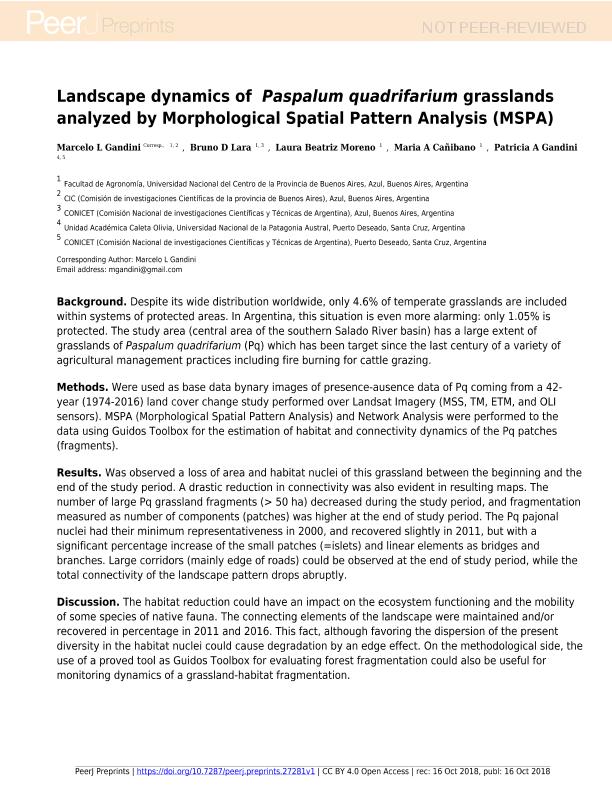Mostrar el registro sencillo del ítem
dc.contributor.author
Gandini, Marcelo Luciano

dc.contributor.author
Lara, Bruno Daniel

dc.contributor.author
Moreno, Laura Beatriz

dc.contributor.author
Cañibano, María Alejandra

dc.contributor.author
Gandini, Patricia Alejandra

dc.date.available
2020-08-18T20:54:27Z
dc.date.issued
2018-10
dc.identifier.citation
Gandini, Marcelo Luciano; Lara, Bruno Daniel; Moreno, Laura Beatriz; Cañibano, María Alejandra; Gandini, Patricia Alejandra; Landscape dynamics of Paspalum quadrifarium grasslands analyzed by Morphological Spatial Pattern Analysis (MSPA); PeerJ Inc; PeerJ; 6; 10-2018; 1-24
dc.identifier.issn
2376-5992
dc.identifier.uri
http://hdl.handle.net/11336/111878
dc.description.abstract
Background. Despite its wide distribution worldwide, only 4.6% of temperate grasslands are includedwithin systems of protected areas. In Argentina, this situation is even more alarming: only 1.05% isprotected. The study area (central area of the southern Salado River basin) has a large extent ofgrasslands of Paspalum quadrifarium (Pq) which has been target since the last century of a variety ofagricultural management practices including fire burning for cattle grazing.Methods. Were used as base data bynary images of presence-ausence data of Pq coming from a 42-year (1974-2016) land cover change study performed over Landsat Imagery (MSS, TM, ETM, and OLIsensors). MSPA (Morphological Spatial Pattern Analysis) and Network Analysis were performed to thedata using Guidos Toolbox for the estimation of habitat and connectivity dynamics of the Pq patches(fragments).Results. Was observed a loss of area and habitat nuclei of this grassland between the beginning and theend of the study period. A drastic reduction in connectivity was also evident in resulting maps. Thenumber of large Pq grassland fragments (> 50 ha) decreased during the study period, and fragmentationmeasured as number of components (patches) was higher at the end of study period. The Pq pajonalnuclei had their minimum representativeness in 2000, and recovered slightly in 2011, but with asignificant percentage increase of the small patches (=islets) and linear elements as bridges andbranches. Large corridors (mainly edge of roads) could be observed at the end of study period, while thetotal connectivity of the landscape pattern drops abruptly.Discussion. The habitat reduction could have an impact on the ecosystem functioning and the mobilityof some species of native fauna. The connecting elements of the landscape were maintained and/orrecovered in percentage in 2011 and 2016. This fact, although favoring the dispersion of the presentdiversity in the habitat nuclei could cause degradation by an edge effect. On the methodological side, theuse of a proved tool as Guidos Toolbox for evaluating forest fragmentation could also be useful formonitoring dynamics of a grassland-habitat fragmentation.
dc.format
application/pdf
dc.language.iso
eng
dc.publisher
PeerJ Inc
dc.rights
info:eu-repo/semantics/openAccess
dc.rights.uri
https://creativecommons.org/licenses/by-nc-sa/2.5/ar/
dc.subject
LAND USE
dc.subject
CATTLE GRAZING
dc.subject
MORPHOLOGY
dc.subject
CONNECTIVITY
dc.subject
PASPALUM QUADRIFARIUM
dc.subject.classification
Conservación de la Biodiversidad

dc.subject.classification
Ciencias Biológicas

dc.subject.classification
CIENCIAS NATURALES Y EXACTAS

dc.subject.classification
Ecología

dc.subject.classification
Ciencias Biológicas

dc.subject.classification
CIENCIAS NATURALES Y EXACTAS

dc.subject.classification
Otras Ciencias de la Tierra y relacionadas con el Medio Ambiente

dc.subject.classification
Ciencias de la Tierra y relacionadas con el Medio Ambiente

dc.subject.classification
CIENCIAS NATURALES Y EXACTAS

dc.title
Landscape dynamics of Paspalum quadrifarium grasslands analyzed by Morphological Spatial Pattern Analysis (MSPA)
dc.type
info:eu-repo/semantics/article
dc.type
info:ar-repo/semantics/artículo
dc.type
info:eu-repo/semantics/publishedVersion
dc.date.updated
2020-01-31T21:05:38Z
dc.identifier.eissn
2167-8359
dc.journal.volume
6
dc.journal.pagination
1-24
dc.journal.pais
Estados Unidos

dc.description.fil
Fil: Gandini, Marcelo Luciano. Provincia de Buenos Aires. Gobernación. Comisión de Investigaciones Científicas; Argentina. Universidad Nacional del Centro de la Provincia de Buenos Aires. Facultad de Agronomía; Argentina
dc.description.fil
Fil: Lara, Bruno Daniel. Universidad Nacional del Centro de la Provincia de Buenos Aires. Facultad de Agronomía; Argentina. Consejo Nacional de Investigaciones Científicas y Técnicas. Centro Científico Tecnológico Conicet - Tandil; Argentina
dc.description.fil
Fil: Moreno, Laura Beatriz. Universidad Nacional del Centro de la Provincia de Buenos Aires. Facultad de Agronomía; Argentina
dc.description.fil
Fil: Cañibano, María Alejandra. Universidad Nacional del Centro de la Provincia de Buenos Aires. Facultad de Agronomía; Argentina
dc.description.fil
Fil: Gandini, Patricia Alejandra. Universidad Nacional de la Patagonia Austral. Unidad Académica Caleta Olivia; Argentina. Consejo Nacional de Investigaciones Científicas y Técnicas; Argentina
dc.journal.title
PeerJ
dc.relation.alternativeid
info:eu-repo/semantics/altIdentifier/url/https://peerj.com/preprints/27281/
Archivos asociados
